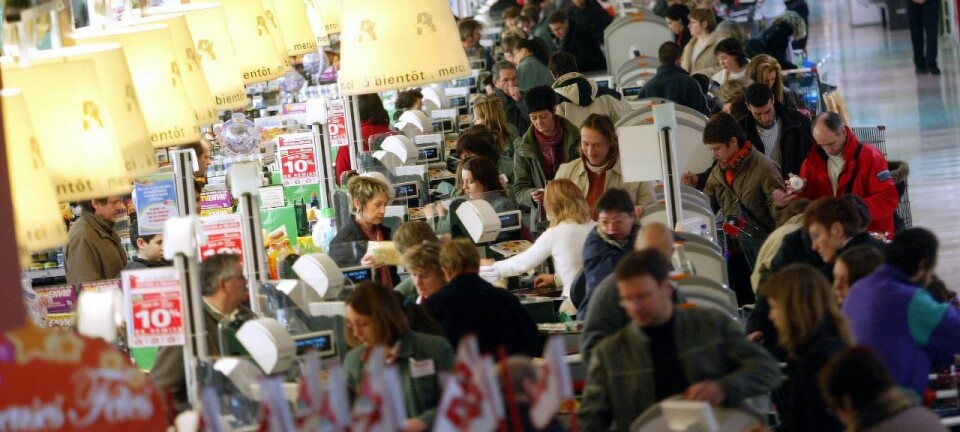
Queues move faster if the last person is served first
Serving the last person to arrive in the queue could surprisingly cut waiting times, shows new research.
It may surprise you to learn that the traditional queue system where people are served in order of arrival, first to last, is the worst way to quickly process people waiting in line.
But this is the conclusion of a new paper by two researchers from the University of Southern Denmark (SDU).
Professor Lars Peter Østerdal and Assistant Professor Trine Tornøe Platz from the Department of Business and Economics, SDU, have published their results as a working paper in the Discussion Papers on Business and Economics by the University of Southern Denmark.
Traditional queues maximize the overall waiting time
They examined a situation where a facility offers a service that opens at a particular time. It can be a ticket sale opening online, a doctor's phone line or a physical queue such as a traffic jam.
In all situations, there is some form of bottleneck, which means that not all will be served at the same time. The participants must decide when to join the queue and assess how long they expect to wait in it.
"The traditional way to settle a queue -- called first-in-first-out -- is perhaps what many associate with a normal and fair queue. Those who have been in the queue the longest will be served first when there is availability," says Østerdal.
According to Østerdal, this unfortunately results in most people queuing for the longest possible time, and in their study, the way the queue is organised caused the participants to join the queue too early.
"A lot of people have the incentive to join the queue early, which means that they stand in line for a long time. Of all the options available to them, this is the worst one," he says.
Østerdal and Platz describe the first-in-first-out queue principle as a curse.
In complete contrast, the researchers suggest that a last-in-first-out system, where the newest arrival is always served first, could be the best possible way to manage a queue; at least in the situations they are investigating. This is because people change their behaviour according to how the queue is managed. If the last arrivals are prioritised first, then the people watching the queue change their mind about when they should join.
Queue principle controls when people start to queue
"It is a highly provocative result," says Mogens Fosgerau, professor of transport policy and behaviour at the Danish Technical University. Fosgerau emphasizes that the research presents a theoretical model where people can control how the queue is managed and have a sense of how long the queue will take at certain times.
"We assume that people act strategically. This means that people adjust when they join the queue according to the queue principle ruling the situation. The core question is what happens when people respond to the way the queue is managed," says Østerdal.
"We look at what happens in the end, when people have adapted their behaviour in a way that no one benefits by doing it differently. If everyone arrived last, some would benefit from joining the queue early. So we cannot have a situation where everyone joins the queue at the last possible minute,” he says.
“During the first-in-first-out system, a large amount of people will typically join the queue right away. Then there is some time where no one joins the queue. And then people start to arrive slowly again.”
“With the last-in-first-out principle there will always be people being served. In this system, there are no great leaps and bounds, and people continue to arrive a little faster than they are served," he says.
Less time waiting in virtual queues
While this sounds attractive, it may not be particularly socially acceptable to stroll down to the bakery on a Sunday morning and jump to the front of the queue, passing those who started queuing hours before opening time.
Neither Østerdal or Fosgerau expect the last-in-first-out system to catch on when it comes to physical queues in the supermarket or traffic jams on the highway, but it could be used to reduce waiting times in telephone and Internet queues.
As an example they mention the situation when the annual tax statements are released online -- about 4.5 million in the state of Denmark -- and hordes of impatient taxpayers rush in to check their taxes.
But Fosgerau also sees how some physical queues could be made to move faster by taking the last arrival first. For example, the large queues that sometimes develop when aircraft are waiting to take off from large airports. A faster queue means fewer delays. The question is is whether those waiting in the queue behave rationally, and if it is possible to manage the queue. An airport certainly makes that possible.
"Aviation companies have a lot of experience and are constantly making calculations on queue situations, so they would be able to manage the planes in such a way that follows the last-in-first-out principle. And in this situation the airport is in full control of managing the aircraft, so it provides a concrete example where delays could be reduced," says Fosgerau.
--------------
Read the Danish version of this article on Videnskab.dk
Translated by: Catherine Jex








